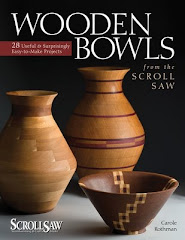One of the workhorses for makers of scroll saw bowls is the flexible pad sander. Invaluable for sanding the exterior of bowls and other curved surfaces, these sanders come in 2" and 3" sizes and several different densities. Discs for these sanders, available with or without scallops, are attached with a hook and loop system. This makes changing grits a snap.
I usually recommend the 2" size sander, in standard density, as a starting point. This density is appropriate for wood removal, and the 2" size is easy to manipulate. The 3" pad is more aggressive, and suitable for larger projects, or those without petals or waves.
Sanders with less dense foam pads are ideal for removing scratch marks left by coarser grits, since they refine the surface without altering the shape of the wood. They are available as complete sanding units, or as add-on pads that attach to the standard pads, using the hook and loop system.
Using an add-on pad is an economical choice, since a single sander can now function in two distinct ways. The add-on pads are also available in the standard density, and can be used to extend the life of the sander. The sanders shown in the photo are both 2", with standard density. The one of the left has a standard density add-on pad. The add-on pad for the one on the right is of thin foam; thicker ones are also available.













